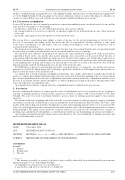Page 683 - SAIT Compendium 2016 Volume2
P. 683
IN 79 Income Tax acT: InTeRPReTaTIon noTes IN 80
produce established under paragraph 40(2)(b) of the Eighth Schedule must therefore be reduced under paragraph 20(3) (a) of the Eighth Schedule by the paragraph 4(1)(a)(ii)(aa) deduction. An heir or legatee who disposes of produce on revenue account will have proceeds of nil because the amount would be included in gross income.*
4.3.7 Insolvency or liquidation
Section 25C deems the estate of a natural person before sequestration and that person’s insolvent estate to be one and the same person for the purpose of determining –
• any allowance, deduction or set off to which that insolvent estate may be entitled;
• any amount which is recovered or recouped by or otherwise required to be included in the income of that insolvent
estate; and
• any taxable capital gain or assessed capital loss of that insolvent estate.
The person before sequestration must submit a return of income for the period commencing on the rst day of the year of assessment and ending on the date before the date of sequestration.† Produce will have a value equal to the lower of production cost and market value for closing stock purposes at the end of that person’s year of assessment in the normal way.
The insolvent estate must submit a return of income for its rst year of assessment from the date of sequestration until the end of that year and for all subsequent years of assessment until the estate is wound up.
The insolvent estate will have an opening stock equal to the value included in closing stock of the person before sequestration based on the ‘one and the same person’ principle. Any assessed loss of the person before the date of sequestration will be brought forward into the insolvent estate. Produce must continue to be brought into closing stock at the lower of production cost and market value in the rst year of assessment of the insolvent estate and for the purposes of determining future opening and closing stock. Any amount received by or accrued to the insolvent estate from the disposal of produce must be included in the gross income of the insolvent estate.
For CGT purposes there is no deemed disposal on date of sequestration as a result of the ‘one and the same person’ principle in section 25C. Given that produce is oating capital there should be no CGT implications when produce is disposed of by the trustee of the insolvent estate.
A company that is being wound up or liquidated remains the same taxable entity until it is nally dissolved.‡ In practice a company must submit an interim return of income for the period from the beginning of the year of assessment up to the date immediately before the date of liquidation and another return from the date of liquidation until the end of the year of assessment. Produce must be brought to account in opening and closing stock in these interim returns at the lower of production cost and market value.
Any amounts derived by the company after date of liquidation must be included in its gross income.
5. Conclusion
Persons conducting the business of a nursery in the course of which plants or trees are grown for sale are regarded as carrying on farming operations. Persons in this category are taxed in accordance with section 26 subject to the First Schedule. The same tests used to determine whether a person carries on farming operations apply to these nursery operators.
The produce held at the beginning and at the end of the year of assessment of a nursery operator carrying on farming operations is speci cally excluded from section 22 and must be dealt with under the First Schedule. The value of the produce held and not disposed of must be brought into account at the beginning and end of the year of assessment. The value to be placed upon the produce on hand is the fair and reasonable value as the Commissioner may x in accordance with paragraph 9. The plants or trees grown by a nursery, which are not ready for sale, will fall into the category of growing crops and must not be brought into account when the taxable income from farming operations is determined.
Any trading stock purchased from outside sources and offered for sale is not attributable to farming operations and must be dealt with under section 22.
INTERPRETATION NOTE: NO. 80
DATE: ACT: SECTION: SUBJECT:
CONTENTS
Preamble
1. Purpose
2. Background 3. The law
* The amount received by or accrued to the heir or legatee will be reduced by the portion included in gross income under paragraph 35(3)(a) of the Eighth Schedule.
† Paragraph (b)(i) of the proviso to section 66(13)(a).
‡ Van Zyl NO v CIR 1997 (1) SA 883 (C), 59 SATC 105.
5 November 2014
INCOME TAX ACT 58 OF 1962
SECTION 11 (a), (c), 23 (c) AND (g) AND SECTION 1 (1), DEFINITION OF ‘GROSS INCOME’ THE INCOME TAX TREATMENT OF STOLEN MONEY
saIT comPendIum oF Tax LegIsLaTIon VoLume 2 675


